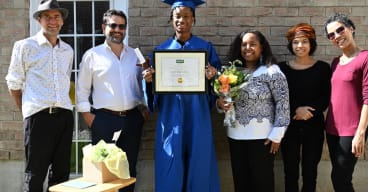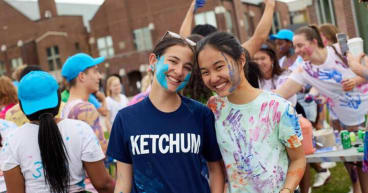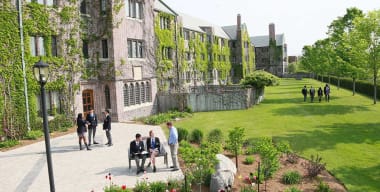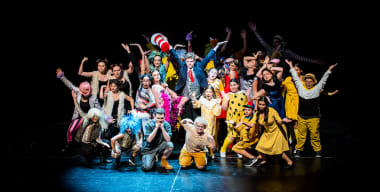Choosing a school for a collaborative learner
Exploring a collaborative learner's school fit
Kids vary widely in their learning preferences. Don’t underestimate the importance of your child’s learning preferences on school choice: it can significantly affect the kind of learning environment, and hence school, that’s right for them.
Collaborative learners enjoy group learning. They often like to work with others in class, interact with their peers, and collaborate on projects, assignments, and other school work.
Below, we identify key points you should reflect on when considering 10 different school types for a collaborative learner. Note: our aim isn’t to tell you whether a school type is right or wrong for you, but to highlight some critical factors you should consider when making your decision.
To learn about how to choose the right school in general, read the Our Kids’ step-by-step advice guide and our expert tips. To get school-choice advice customized to your child's unique traits, create a child profile through your user account and read our seven ways to choose a school based on your child's needs (i.e., overall fit, more academic challenge, social struggles, academic struggles, intensive learning interests, university preparation, and special needs.).
Collaborative learners’ fit in 10 school types
On this page:
School size
Gender
Curriculum
Living arrangements
School size
Small school (150 students or less)
Small schools with smaller classes offer more opportunities for the kind of group work collaborative learners enjoy. Whether it’s discussion groups, project work, or peer-to-peer teaching, they tend to offer plenty of group activities in an inclusive environment.
Also, “Small schools often have a family-like feeling, because the class sizes are so small,” say Ann and Karen Wolff of Wolff Educational Services. “They form a sense of community across the grades. You get these cross-grade friendships, relationships, and mentoring if it gives certain kids leadership opportunities, something they would rarely have in a larger school.”
Big school (151+ students)
Big schools vary widely in their learning environments and approaches. While some stress collaborative learning and provide lots of group activities, others don’t. That said, with many classes and diverse student cohorts, big schools can often accommodate and nurture a wide range of learning styles, including collaborative learning.
Since big schools have larger student populations, they often have more extracurriculars and supplementals for students to pursue group learning activities like debate and student government. Also, “Due to their large numbers of students, they offer more opportunities to find a group of like-minded peers, in class and out,” say Ann and Karen Wolff of Wolff Educational Services.
Gender
Coed school
Coed schools vary in their focus on collaborative learning. Most, however, provide at least some group learning activities, such as project work, class discussions, and peer-to-peer teaching. Since this will depend on a school’s curricular approach and class sizes, ask exactly what’s offered and what this looks like. Also, look into whether a school has extracurriculars which involve collaborative or social learning, such as debate and musical theatre.
In a coed school, your child will work with and learn from the experiences of both boys and girls. This can widen their perspective and enhance their academic development. “Some research shows that girls and boys often learn, think, and see things differently,” says Stacey Jacobs, Director of Clear Path Educational Consulting. “Bringing these two dynamics together allows students to experience the best of both worlds.”
Girls' school
Many girls’ schools emphasize collaborative and group learning. This often involves plenty of interaction, discussion, and open-ended inquiry. “Just ask a school how it meets the learning needs of girls, and how it will meet your daughter’s needs,” says Stacey Jacobs, Director of Clear Path Education. “Most girls’ schools recognize that learning styles vary widely, even within a single gender.”
Also, in a girls-only school, your daughter can seek out and interact with different peer groups without having to navigate boy-girl interactions. She’ll find it easier to focus on finding like-minded peers and to pursue social and learning opportunities without the intense pressure of having to interact and negotiate relationships with boys.
Boys' school
Many boys’ schools emphasize collaborative and group learning. Sometimes this includes experiential, hands-on learning, which many collaborative learners enjoy. “Just ask a school how it meets the learning needs of boys, and how they will meet your son’s needs,” says Stacey Jacobs, Director of Clear Path Education. “Most boys’ schools recognize that learning styles vary widely, even within a single gender.”
Also, in an all-boys school, your son can seek out and interact with different peer groups free from the complexities of boy-girl interactions. He’ll find it easier to focus on finding like-minded peers and pursuing social and learning opportunities without the intense pressure and distraction associated with interacting with the other gender. “A fraternal camaraderie is also sometimes seen in these schools,” says Joanne Foster, education consultant and author of ABCs of Raising Smarter Kids. “That kind of milieu can be very supportive.”
Curriculum
Montessori school
Montessori schools have a child-focused educational approach with lots of individualized learning. For some schools, this includes uninterrupted independent work periods of up to three hours a day, which can be daunting for some collaborative learners.
That said, most Montessori schools, from preschool to the secondary level, provide kids with plenty of opportunities to work in small groups on specific tasks and projects. Classrooms are also normally divided into three-year age groups, which will enable your child to both learn from and mentor their peers, something collaborative learners tend to love.
Reggio Emilia school
Reggio Emilia schools enable kids to work alongside their classmates in a variety of contexts. Collaborative learning is a major focus: kids often work in groups on tasks, assignments, and projects, and aim to explore issues and solve problems with their peers.
In Reggio Emilia schools, teachers consider children’s relationships to one another and aim to promote positive connections between them—a blessing for collaborative learners (as it can be for other types of learners). Classrooms are set up to promote lots of interaction and group learning, which can help your child engage fully with their work and develop key social skills.
International Baccalaureate school
Throughout the continuum—from the Primary Years Programme (PYP) to the Diploma Programme (DP)—the IB offers plenty of group work, projects, and activities, which collaborative learners tend to love. Also, “Since they have a strong emphasis on community service and activism, your child will have many opportunities to harness their collaborative learning style,” says Stacey Jacobs, Director of Clear Path Education. Finally, IB schools give your child the unique opportunity to interact and spend time with a bright, motivated, and ambitious group of kids who may have interests similar to them.
That said, the IB programme’s high-level academics and heavy workload are demanding. If your child is less academically-focused or needs lots of one-on-one support, they may find it a tall order. Since IB schools are run in different ways, talk to directors and staff to determine whether your child is likely to be a good fit.
Language immersion school
The demanding curriculum of language immersion schools, which requires students to learn all or most of their subjects in a second language, can sometimes be restrictive for collaborative learners. Some of these schools don’t provide enough time for the types of group learning activities collaborative learners crave. Also, learning and speaking in a foreign tongue can make it difficult for your child to communicate and interact with their classmates, which can be frustrating.
That said, collaborative learners who enjoy and are good at the language arts often welcome the challenge of learning in a different language. If they’re hard workers and enjoy conversing, networking, and practicing the language they’re studying with others, then a language immersion school can be a good fit.
Living arrangements
Boarding school
Boarding schools have a wide range of learning environments. While some prioritize collaborative and group learning, others don’t. Of course, since they often have more classes and bigger student cohorts, they can normally accommodate a broad scope of learning styles, including both collaborative and independent learning.
Since boarding schools tend to have larger student populations, they often have more extracurriculars which involve group or collaborative learning, such as debate and student government. Also, “Due to their large numbers of students, they offer more opportunities to find a group of like-minded peers,” say Ann and Karen Wolff of Wolff Educational Services. This can give your child the opportunity to explore interesting and dynamic social learning opportunities, in and out of class.
Collaborative learners’ school fit: key take-homes
- Since big schools have larger student populations, they often have more extracurriculars and supplementals for students to pursue group learning activities like debate and student government.
- Small schools with smaller classes offer more opportunities for the kind of group work collaborative learners enjoy. Whether it’s discussion groups, project work, or peer-to-peer teaching, they tend to offer plenty of group activities in an inclusive environment.
- Many boys’ schools emphasize collaborative and group learning. Sometimes this includes experiential, hands-on learning, which many collaborative learners enjoy.
- Many girls’ schools emphasize collaborative and group learning. This often involves plenty of interaction, discussion, and open-ended inquiry.
- Montessori schools have a child-focused educational approach with lots of individualized learning, which includes uninterrupted independent work periods of up to three hours a day, which can be daunting for some collaborative learners. That said, most Montessori schools, from preschool to the secondary level, provide kids with plenty of opportunities to work in small groups on specific tasks and projects.
- Reggio Emilia schools enable kids to work alongside their classmates in a variety of contexts. Collaborative learning is a major focus: kids often work in groups on tasks, assignments, and projects, and aim to explore issues and solve problems with their peers.
- Throughout the continuum—from the Primary Years Programme (PYP) to the Diploma Programme (DP)—the IB offers plenty of group work, projects, and activities, which collaborative learners tend to love. Also, “Since they have a strong emphasis on community service and activism, your child will have many opportunities to harness their collaborative learning style,” says Stacey Jacobs, Director of Clear Path Education.
- The demanding curriculum of language immersion schools, which requires students to learn all or most of their subjects in a second language, can sometimes be restrictive for collaborative learners. Some of these schools don’t provide enough time for the types of group learning activities collaborative learners crave.









